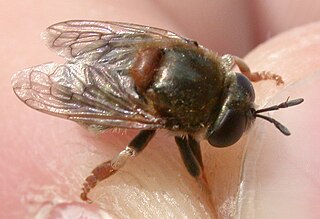
Hover flies, also called flower flies or syrphid flies, make up the insect family Syrphidae. As their common name suggests, they are often seen hovering or nectaring at flowers; the adults of many species feed mainly on nectar and pollen, while the larvae (maggots) eat a wide range of foods. In some species, the larvae are saprotrophs, eating decaying plant and animal matter in the soil or in ponds and streams. In other species, the larvae are insectivores and prey on aphids, thrips, and other plant-sucking insects.

Eristalinae are one of the four subfamilies of the fly family Syrphidae, or hoverflies. A well-known species included in this subfamily is the dronefly, Eristalis tenax.

Dasysyrphus is a genus of hover flies with 50 identified species distributed worldwide. While the genus is relatively easy to identify, genera key the differences between species have a more narrow range of variations. Therefore, identification of species by images of specimens alone should be made with care.

Dasysyrphus venustus is a Holarctic species of hoverfly.

Platycheirus manicatus is a species of hoverfly. It is found across the Palearctic and in Alaska.

Ferdinandea is a genus of syrphid flies or hoverflies in the family Syrphidae. There are about 16 described species in Ferdinandea.

Brachyopa is a Holarctic genus of hoverflies whose grey and brown colouration is unusual for this family and these flies can easily be overlooked amongst members of other fly families. The larvae can be found under the bark of dead branches and trees in decaying sap.

These are small black and yellow or mostly black flies with a narrow abdomen near the thorax. They occur mainly in damp places among low herbage. The larva of Neosascia are flattened without oral hooks and a have a short posterior spiracular process or "tail" rat-tailed that is saprophagous. In 1925 Curran reviewed the genus Neoascia. In this work a key is provided and ten species are described including four new species some of which have later been determined to be synonyms.

Anasimyia is a genus of wetland hoverflies with aquatic larvae. The genus was formerly regarded as a subgenus of the similar Lejops, and recently elevated to genus.

Lejops is a genus of hoverflies, closely related to the genera Helophilus, Quichuana and Mallota.

Microdon mutabilis, is a species of hoverfly. It is found in many parts of Britain and Europe. The distinctive almost slug-like larvae live in ants' nests. They are hemispherical in shape, heavily armoured and believed to prey on the eggs and larvae of a number of ant species, including Formica lemani, Formica fusca, Lasius niger and Myrmica ruginodis. It was described by Carl Linnaeus in his landmark 1758 10th edition of Systema Naturae.

The Brachyopini is a tribe of hoverflies. Unlike many members of this family these flies are generally darker and less colourful though some genera contain species with an attractive metallic lustre e.g. Chrysogaster. Some like Brachyopa are associated with sap runs where their larvae feed on decaying sap. Others are found in boggy areas where their often semiaquatic larvae feed on decaying organic matter.

Eristalini is a tribe of hoverflies. Several species are well-known honeybee mimics, such as the drone fly Eristalis tenax, while other genera such as Helophilus and Parhelophilus exhibit wasp-like patterns of yellow and black stripes, both strategies to avoid predation by visual predators such as birds.

The Milesiini is a large and diverse tribe of hoverflies. They mimic wasps or hornets.

Pipizini is a tribe of small to medium-sized generally black hoverflies, although some species also have orange spots on their abdomen. This nondescript colouring can lead to some species being confused with other dark hoverflies from other tribes. The lack of a facial knob is a good defining feature which separates them from most of these other hoverflies. As with other species in the subfamily Syrphinae the larvae feed on aphids though there seems to be a preference for wax-secreting aphids e.g. Pemphigidae.
Anasimyia transfuga is a Palearctic species of hoverfly.

Sphegina elegans is a species of hoverfly.
Eumerus tuberculatus, the lesser bulb fly is a species of hoverfly from the family Syrphidae, in the order Diptera. It is a pest that destroys the bulbs of Narcissus.

The Spheginina is a subtribe of hoverflies.
















